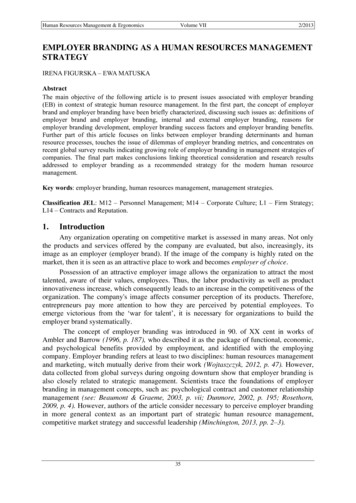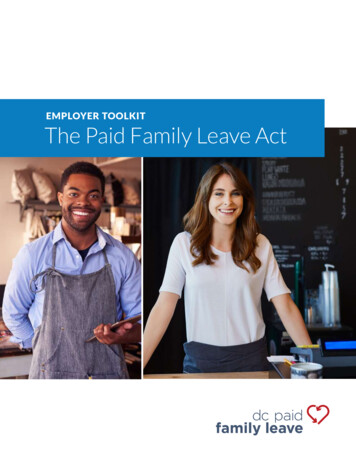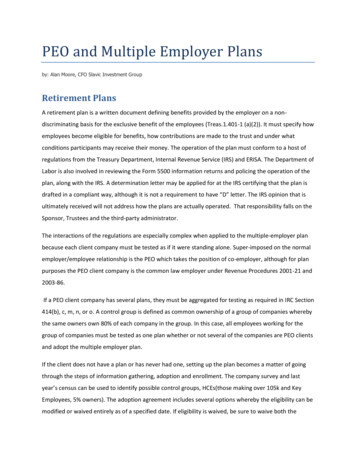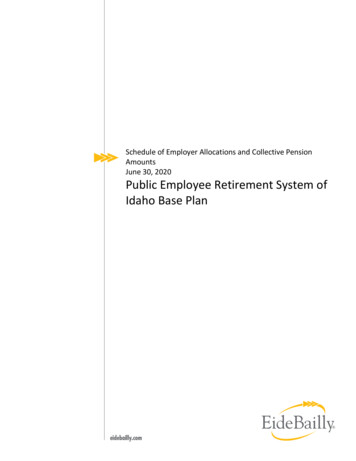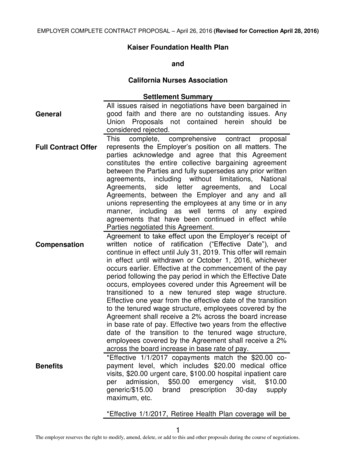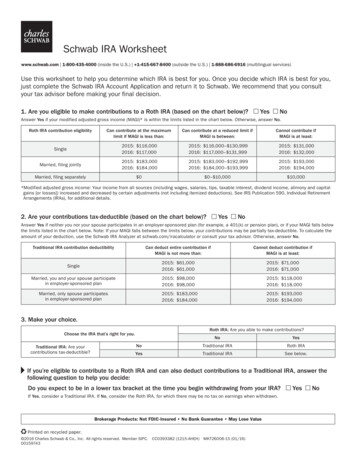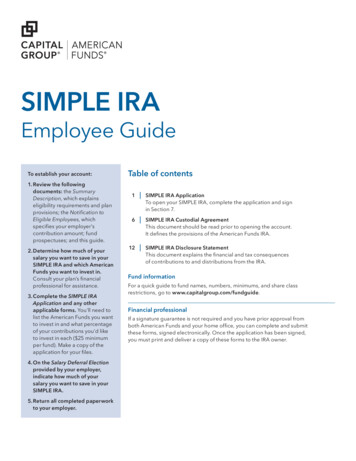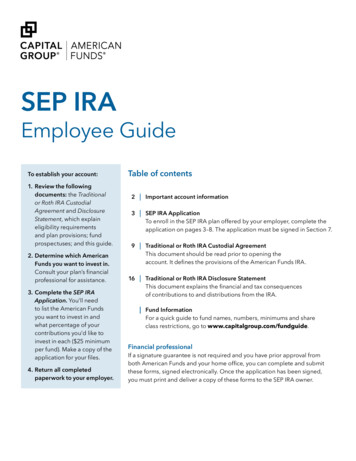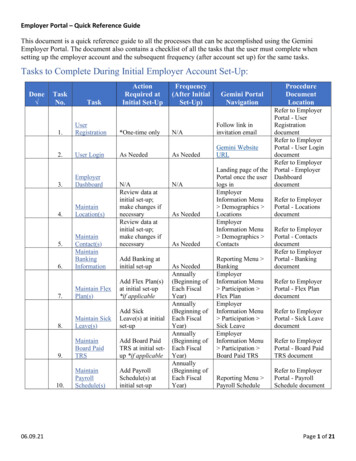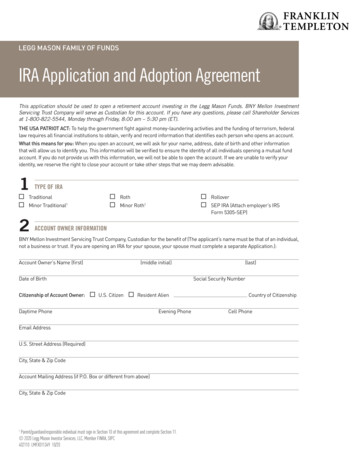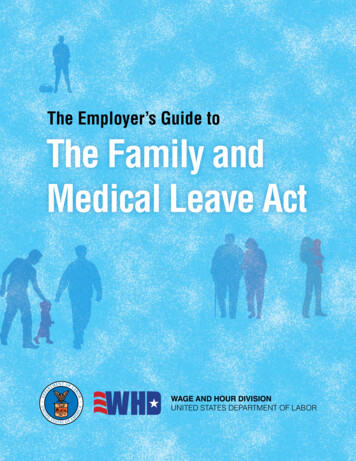
Transcription
The Employer’s Guide toThe Family andMedical Leave ActWAGE AND HOUR DIVISIONUNITED STATES DEPARTMENT OF LABOR
The Department of Labor has provided this guide as a public service. It is intended as general informationonly and does not carry the force of legal opinion. The Department reserves the right to update the materialand information contained herein to ensure it is accessible, easy to understand and educational, andconforms with regulatory or statutory changes in the law. The Federal Register and the Code of FederalRegulations remain the official sources for regulatory information published by the Department of Labor.MESSAGE FROM WAGE AND HOUR DIVISIONSince its enactment in 1993, the Family and Medical Leave Act (FMLA) has served as the cornerstoneof the Department of Labor’s efforts to promote work-life balance and we have worked in support of theprinciple that no worker should have to choose between the job they need and the family they love. Withthe FMLA, our country made it a priority to give workers the ability to balance the demands of work andfamily. It made the healthy development of babies, healthy families, and healthy workplaces a priority. Itwas a remarkable accomplishment at the time and, since its enactment, the FMLA has been used morethan 100 million times to help workers balance the demands of the workplace with the needs of theirfamilies and their own health.
CONTENTSINTRODUCTION6CHAPTER 1 – COVERED EMPLOYERS UNDER THE FMLA AND THEIRGENERAL NOTICE REQUIREMENTSCovered EmployersPrivate Sector EmployerPublic AgencySchoolsOther Ways Employers May Be Covered under the FMLAAn Employer’s Obligation to Provide Employees with General Notice of FMLA RightsPosting RequirementProviding General Notice to EmployeesCHAPTER 2 – WHEN AN EMPLOYEE NEEDS FMLA LEAVEAn Employee’s Obligation to Provide Notice of the Need for LeaveContent of an Employee’s NoticeTiming of an Employee’s Notice – Leave that Is ForeseeableTiming of an Employee’s Notice – Leave that Is UnforeseeableEmployee Eligibility12 Months of Employment1,250 Hours of Service50 Employees within 75 miles of the Employee’s WorksitePublic Agency and School EmployeesSpecial Eligibility Rule for Airline Flight Crew EmployeesAn Employer’s Obligation to Provide Employees with an Eligibility NoticeAn Employer’s Obligation to Provide Employees with a Rights and Responsibilities NoticeContents of the Rights and Responsibilities NoticeCHAPTER 3 – QUALIFYING REASONS FOR 2324252525Circumstances that Qualify for FMLA LeaveImmediate Family MembersIn Loco ParentisDocumenting the Family RelationshipSerious Health ConditionCHAPTER 4 – THE CERTIFICATION PROCESSCircumstances When an Employer May Require a CertificationHealth Care ProvidersMedical Certification Notice and TimingContents of a Complete and Sufficient Medical CertificationAppropriate Medical Facts282929293031The Employer’s Guide to the Family and Medical Leave Act3
CONTENTSAdditional Information for Intermittent or Reduced Schedule LeaveIncomplete or Insufficient Medical CertificationMedical Certification from AbroadAuthentication and ClarificationSecond and Third OpinionsRecertificationAnnual Medical CertificationCHAPTER 5 – MILITARY FAMILY LEAVETypes of Military Family LeaveQualifying Exigency LeaveCovered Active DutyFamily Members for Whom an Employee May Take Qualifying Exigency LeaveQualifying Exigency CategoriesCertification for Qualifying Exigency LeaveMilitary Caregiver LeaveCovered ServicememberFamily Members for Whom an Employee May Take Military Caregiver LeaveA Serious Injury or IllnessA “Single 12-Month Period”Certification for Military Caregiver LeaveCHAPTER 6 – DURING AN EMPLOYEE’S FMLA LEAVEDesignation of FMLA Leave and an Employer’s Obligation toProvide Employees with a Designation NoticeContents of the Designation NoticeFitness-for-Duty CertificationRetroactive Designation of FMLA LeaveRules for Scheduling and Taking FMLA LeaveA 12-Month Leave YearIntermittent Leave or Reduced Schedule LeaveTransfer to an Alternative PositionSpouses Working for the Same EmployerSpecial Rules for School Instructional EmployeesCalculating FMLA LeaveIncrements of FMLA Leave for Intermittent or Reduced Schedule LeaveSpecial Rules for Airline Flight Crew EmployeesSubstitution of Paid LeaveFMLA and Other Paid LeavesEffect of Unpaid Leave for Salaried Employees under the Fair Labor Standards ActMaintenance of Benefits4The Employer’s Guide to the Family and Medical Leave 95051515253535455555757585859
CONTENTSGroup Health PlanEmployer ResponsibilitiesMulti-Employer Health PlansEmployee ResponsibilitiesEmployee Failure to Pay Health Plan Premium PaymentWhen an Employee Fails to Return to WorkRestorationLimitations on an Employee’s Right to Return to WorkRecordkeeping Requirements and Other LawsRecordkeeping RequirementsContent of RecordsConfidentiality of RecordsAirline Flight Crew EmployeesInteraction with Other Federal and State Laws, and an Employer’s PoliciesAmericans with Disabilities Act (ADA)Pregnancy Discrimination Act (PDA)Consolidated Omnibus Budget Reconciliation Act (COBRA)Uniformed Services Employment and Reemployment Rights Act (USERRA)Health Insurance Portability and Accountability Act (HIPAA) Privacy RuleWorkers’ CompensationInteraction with State Family and Medical Leave LawsInteraction with an Employer’s PoliciesCHAPTER 7 – FMLA 69707071The Employer’s Guide to the Family and Medical Leave Act5
INTRODUCTIONThe Family and Medical Leave Act (FMLA) is a federal law that provides eligible employees of coveredemployers with unpaid, job-protected leave for specified family and medical reasons. Eligible employeesmay take up to 12 workweeks of leave in a 12-month period for one or more of the following reasons: The birth of a son or daughter or placement of a son or daughter with the employee for adoption orfoster care, and to bond with the newborn or newly-placed child; To care for a spouse, son, daughter, or parent who has a serious health condition, includingincapacity due to pregnancy and for prenatal medical care; For a serious health condition that makes the employee unable to perform the essential functions ofhis or her job, including incapacity due to pregnancy and for prenatal medical care; or For any qualifying exigency arising out of the fact that a spouse, son, daughter, or parent is amilitary member on covered active duty or call to covered active duty status.An eligible employee may also take up to 26 workweeks of leave during a single 12-month period tocare for a covered servicemember with a serious injury or illness when the employee is the spouse, son,daughter, parent, or next of kin of the servicemember. An eligible employee is limited to a combined totalof 26 workweeks of leave for any FMLA-qualifying reasons during the single 12-month period.In addition to providing eligible employees an entitlement to leave, the FMLA requires that employersmaintain employees’ health benefits during leave and restore employees to their same or an equivalent jobafter leave. The law sets requirements for notice, by both the employee and the employer, and providesemployers with the right to require certification of the need for FMLA leave in certain circumstances. Thelaw protects employees from interference and retaliation for exercising or attempting to exercise theirFMLA rights. The law also includes certain employer recordkeeping requirements.The U.S. Department of Labor’s Wage and Hour Division is responsible for administering and enforcingthe FMLA for most employees. In most instances, an employee also has the right to file a private law suitunder the FMLA in any federal or state court of competent jurisdiction.The Wage and Hour Division is committed to strengthening compliance with the FMLA by providingassistance to employers and helping increase their knowledge of the law. This Employer’s Guide to theFamily and Medical Leave Act is designed to provide essential information about the FMLA, includinginformation about employers’ obligations under the law and the options available to employers inadministering leave under the FMLA. The Guide is organized to correspond to the order of events from anemployee’s leave request to restoration of the employee to the same or equivalent job at the end of theemployee’s FMLA leave. It also includes a topical index for ease of use.The Department of Labor is providing this Guide in an effort to increase public awareness of the FMLAand of the various Departmental resources and services available to the public. This publication is aguidance document that is subject to change in the future. The United States Code, Federal Register, andthe Code of Federal Regulations remain the official sources for legislative and regulatory information. Formore information about the FMLA, please visit the Department’s website at dol.gov/whd/fmla, call us at1-866-4US-WAGE (1-866-487-9243), or visit the nearest Wage and Hour Division Office.6The Employer’s Guide to the Family and Medical Leave Act
INTRODUCTIONVisit the Department’s website for resources containing information about the FMLA including: Key NewsGeneral GuidanceThe Employee’s Guide to the Family and Medical Leave ActThe Employer’s Guide to the Family and Medical Leave ActFact SheetsE-ToolsFMLA PowerPointPostersFormsInterpretive GuidanceLawRegulationsThe Employer’s Guide to the Family and Medical Leave Act7
825THE EMPLOYER’S ROAD MAP TO THE FMLACovered EmployerDisplay the FMLA poster &provide General Notice12Employee asks for FMLAor the employer learns theemployee’s leave may be foran FMLA qualifying reason3Determine if the employeeis eligible4Provide Eligibility andRights & ResponsibilitiesNotices to the employee5Certification ProcessOptionalNone RequiredLet the employee knowthat a Certification willbe required6Grant or deny the leaverequest & provideDesignation Notice tothe employeeDetermine if the leaverequest is for anFMLA-qualifying reason87Maintain Health Benefitsduring the leaveRestore the employeeto the same or an equivalentposition at the end ofthe leaveMaintain records properly91011
CHAPTER 1COVERED EMPLOYERS UNDER THE FMLA ANDTHEIR GENERAL NOTICE REQUIREMENTSCovered EmployersThe FMLA applies only to “covered” employers. A covered employer may be a private-sector employer, a publicagency, or a school. Covered employers must provide FMLA benefits and protections to eligible employeesand comply with other responsibilities required under the FMLA and its regulations at 29 CFR Part 825.Private Sector EmployerA private-sector employer is covered by the FMLA if it employs 50 or more employees* in 20 or more workweeksin the current or previous calendar year. An employee is considered to be employed each working day of thecalendar week if the employee works any part of the week. The workweeks do not have to be consecutive.Employees who must be counted include: Any employee who works in the United States, or any territory or possession of the United States, Any employee whose name appears on payroll records, whether or not any compensation is received forthe workweek, Any employee on paid or unpaid leave (including FMLA leave, leaves of absences, disciplinary suspension,etc.), as long as there is a reasonable expectation the employee will return to active employment, Employees of foreign firms operating in the United States, and Part-time, temporary, seasonal, and full-time employees.Others who do NOT have to be counted include: Employees with whom the employment relationship has ended, such as employees who have been laid off, Unpaid volunteers who do not appear on the payroll and do not meet the definition of an employee, Employees of United States firms stationed at worksites outside the United States, its territories, orpossessions, and Employees of foreign firms working outside the United States.DID YOU KNOW?Once an employer meets the requirement for FMLA coverage, the employer is a covered employer andwill remain covered as long as it employs 50 or more employees in 20 or more workweeks in either thecurrent calendar year or in the previous calendar year.For example, last year during its busy season from June 1st to October 31st, a restauranthad more than 50 employees on payroll. In the current year, the same restaurant employsfewer than 50 employees when an employee requests FMLA leave. Because the restaurantemployed more than 50 employees for more than 20 workweeks in the previous year, therestaurant is considered to be covered at the time of the request and must offer the FMLAbenefits and protections to its employee, if eligible.Review sections 825.104 and 825.105 of the FMLA regulations for more information about coverage.* The term “employee” means any individual employed by an employer. An employee is employed when he or she is “suffered or permitted”to work, as defined under the Fair Labor Standards Act.The Employer’s Guide to the Family and Medical Leave Act9
CHAPTER 1COVERED EMPLOYERS UNDER THE FMLA ANDTHEIR GENERAL NOTICE REQUIREMENTSPublic AgencyPublic agencies are covered employers under the FMLA, regardless of the number of employees they employ.Public agencies include: The federal government, The government of a state or political subdivision of a state, and An agency of the United States, a state, or a political subdivision of a state, including counties, cities andtowns, or any interstate governmental agency. The term “state” includes any state within the United States, the District of Columbia, and any territory orpossession of the United States.Review section 825.108 of the FMLA regulations for more information about public agencycoverage.Federal GovernmentThe Office of Personnel Management administers the FMLA for most federal employees. The Wage and HourDivision administers the FMLA for a limited number of federal employees, including employees of the: United States Postal Service,Postal Regulatory Commission,Federal Aviation Administration, andThe judicial branch of the United States (in certain circumstances).Review section 825.109 of the FMLA regulations for more information about coverage of a federalagency.SchoolsLocal educational agencies are covered under the FMLA, regardless of the number of employees they employ.Such educational agencies include: Public school boards, Public elementary and secondary schools, and Private elementary and secondary schools.Review section 825.600 of the FMLA regulations for more information about coverage of schools.10The Employer’s Guide to the Family and Medical Leave Act
CHAPTER 1COVERED EMPLOYERS UNDER THE FMLA ANDTHEIR GENERAL NOTICE REQUIREMENTSOther Ways Employers May Be Covered under the FMLAIntegrated EmployersA corporation is a single employer under the FMLA rather than its separate establishments or divisions; allemployees of the corporation, at all locations, are counted for coverage purposes.In addition, separate businesses may be parts of a single employer for FMLA purposes if they are anintegrated employer. Factors to be considered in determining if separate businesses are an integratedemployer include: Common management,Interrelation between operations,Centralized control of labor relations, andDegree of common ownership or financial control.For purposes of determining employer coverage under the FMLA, the employees of all entities making up theintegrated employer must be counted.Review section 825.104(c) of the FMLA regulations for more information about coverage forintegrated employers.Joint EmployersWhere two or more businesses exercise some control over the work or working conditions of an employee,such as with a temporary employment agency, the businesses may be joint employers under the FMLA. Forpurposes of determining employer coverage under the FMLA, employees jointly employed by two employersmust be counted by both employers, even if the employees are maintained on only one of the employer’spayrolls.DID YOU KNOW?Two (or more) businesses may simultaneously employ an employee, making them joint employersof the employee. For example, joint employment ordinarily will exist when a temporary employmentagency supplies employees to a second employer. In that case, the employee must be counted byboth employers when determining FMLA coverage.Review section 825.106 of the FMLA regulations for more information about coverage for jointemployers.The Employer’s Guide to the Family and Medical Leave Act11
CHAPTER 1COVERED EMPLOYERS UNDER THE FMLA ANDTHEIR GENERAL NOTICE REQUIREMENTSSuccessor EmployersAn employer may be a covered employer if it takes over the business operations (i.e., becomes a“successor in interest”) of a covered employer. Some of the factors to be considered in determining if anemployer is a successor include: Continuing the same business operations and providing similar products or services,Providing similar jobs and working conditions,Continuing to use the same work force and supervisor structure, andUsing the same location and similar equipment and production methods.Review section 825.107 of the FMLA regulations for more information about coverage of asuccessor in interest employer.An Employer’s Obligation to Provide Employeeswith General Notice of FMLA RightsEvery employer covered by the FMLA must provide a general noticeto their employees regarding the FMLA. To satisfy the general noticerequirement, employers must (1) display or post a general notice(referred to as a poster), and (2) if the employer has any FMLAeligible employees, provide a written general notice to employees.Posting RequirementEvery employer covered by the FMLA must display or post aninformative general notice about the FMLA. The poster must be displayed in plain view where allemployees and applicants can readily see it, and must havelarge enough text so it can be easily read. The information displayed on the poster must explain theFMLA provisions and provide information on how to file acomplaint with the Wage and Hour Division. This poster must be displayed even if no employees arecurrently eligible for FMLA leave. If a significant portion of an employer’s employees do not read and write English, the employer mustprovide the General Notice in a language in which they can read and write. Spanish language FMLAposters are available from the nearest Wage and Hour Division office or online at dol.gov/whd/fmla.When providing FMLA notices to sensory-impaired individuals, employers must also comply with allapplicable requirements under federal and state law.12The Employer’s Guide to the Family and Medical Leave Act
CHAPTER 1COVERED EMPLOYERS UNDER THE FMLA ANDTHEIR GENERAL NOTICE REQUIREMENTSEmployers who willfully violate this posting requirement may be assessed a civil money penalty for eachseparate offense. Employers may use the Department’s FMLA Poster, which is free and publicly availableon the Department’s website, dol.gov/whd/fmla, to satisfy this requirement.Employers may make the poster available electronically, create their own poster, or use another format, aslong as the information provided includes, at a minimum, all the information contained in the Department’sFMLA Poster, is viewable by applicants for employment and current employees, and meets all otherposting requirements.Providing General Notice to EmployeesIn addition to displaying a poster, if a covered employer has any FMLA eligible employees, it must alsoprovide each employee with a general notice about the FMLA in the employer’s employee handbookor other written materials about leave and benefits. If no handbook or written leave materials exist, theemployer must distribute this general notice to each new employee upon hire.This general notice requirement can be met by either duplicating the general notice language found onthe Department’s FMLA Poster or by using another format as long as the information provided includes,at a minimum, all the information contained in the Department’s FMLA Poster. The general notice may bedistributed electronically provided all the requirements are met.Review section 825.300(a) of the FMLA regulations for more information about the generalnotice provisions.The Employer’s Guide to the Family and Medical Leave Act13
CHAPTER 2WHEN AN EMPLOYEE NEEDS FMLA LEAVEEffective communication is critical at all stages of the FMLA process and is a key component ofsuccessfully administering the FMLA. Keeping open lines of communication is especially importantbecause employees do not have to specifically request FMLA leave in order to be entitled to it initially.Bobby: Can Itake a few weeksoff to help mymom recoverfrom surgery?Will (thinking):This could qualifyfor FMLA leave thatI heard about in themanagers’ traininglast month.MNGRWill: Pleaseput in a leaverequest.Will:I will talk toHR about thenext steps.MNGRMNGRMNGRAn Employee’s Obligation to Provide Notice of theNeed for LeaveEmployees must provide notice of their need for FMLA leave. In general, an employer may require thatemployees comply with the employer’s usual and customary policies for requesting leave, unless unusualcircumstances prevent the employee from doing so. The employer can take action under its internalrules and procedures if the employee fails to follow its usual and customary rules for requesting leave.Employers may not, however, discriminate against employees taking FMLA leave. An employer may alsochoose to waive the employee’s notice requirement or its own internal rules about leave requests.Content of an Employee’s NoticeAn employee’s notice of a need for FMLA leave may be oral or written. The first time the employeerequests leave for a qualifying reason, he or she is not required to specifically mention the FMLA.However, the employee is required to provide enough information for the employer to know that the leavemay be covered by the FMLA. For foreseeable leave, the employee must also indicate when and howmuch leave is needed.Once approved for a particular FMLA leave reason, if additional leave is needed for that same reason,the employee may be required to reference that reason or the FMLA. In all cases, the employer may askadditional questions to determine if the leave is FMLA-qualifying.Timing of an Employee’s Notice - Leave that Is ForeseeableGenerally, an employee must give at least 30 days advance notice of the need to take FMLA leave whenhe or she knows about the need for the leave in advance and it is possible and practical to do so. Forexample, if an employee is scheduled for surgery in two months, the need for leave is foreseeable and theemployee must provide at least 30 days advance notice. If an employee does not provide at least 30 daysadvance notice, and it was possible and practical to do so, the employer may delay the FMLA leave until30 days after the date that the employee provides the notice.14The Employer’s Guide to the Family and Medical Leave Act
CHAPTER 2WHEN AN EMPLOYEE NEEDS FMLA LEAVEIf 30 days advance notice is not possible because the foreseeable situation has changed or the employeedoes not know exactly when leave will be required, the employee must provide notice of the need for leaveas soon as possible and practical.In the case of FMLA leave for a qualifying exigency of a military family member, the employee must givenotice of the need for such leave as soon as possible and practical, regardless of how far in advance theleave is needed.For planned medical treatment, the employee must consult with his or her employer and try to schedulethe treatment at a time that minimizes the disruption to company operations. The employee should consultwith the employer prior to scheduling the treatment in order to arrange a schedule that best suits theneeds of both the employee and employer. Of course, any schedule of treatment is subject to the approvalof the treating health care provider.Timing of an Employee’s Notice - Leave that Is UnforeseeableWhen the need for leave is unexpected, the employee must provide notice as soon as possible andpractical. It should usually be reasonable for the employee to provide notice of leave that is unforeseeablewithin the time required by the employer’s usual and customary notice requirements. Whether theemployee’s notice of unforeseeable leave is timely will depend upon the facts of the particular case.For example, if the employee’s child has a severe asthma attack and the employee takesthe child to the emergency room, the employee is not required to leave the child to reportthe absence while the child is receiving emergency treatment. However, if the child’sasthma attack required only the use of an inhaler at home followed by a period of rest,the employee would be expected to call the employer promptly after ensuring the childhas used the inhaler.DID YOU KNOW?As soon as an employer has enough information that indicates an employee’s need for leave maybe for an FMLA-qualifying reason, the employer should begin the FMLA leave process.An employer’s management team and leave administrators play a vital role in ensuring FMLAcompliance. Managers, assistant managers, supervisors and leave administrators must be ableto recognize FMLA-qualifying reasons for leave and properly initiate the required notificationsand eligibility checks. Providing FMLA training regularly helps to make sure those responsible forimplementing the FMLA are up-to-date on the requirements of the law and the employer’s policy,procedures and practices. Keeping everyone informed, for example by using the FMLA powerpoint found on the Wage and Hour Division’s FMLA webpage, can help an employer stay incompliance with the law.Review sections 825.302 and 825.303 of the FMLA regulations for more information aboutemployee notice requirements.The Employer’s Guide to the Family and Medical Leave Act15
CHAPTER 2WHEN AN EMPLOYEE NEEDS FMLA LEAVEEmployee EligibilityWill (on phone):Brenda, I have aworker who wants totake leave to care forhis mother. I think hemay be eligible forFMLA leave.FMLA Leave RequestWill (on phone):I told him to put ina leave request. Isthere anything elseI should do?Brenda: I’ll checkhis records tosee if he is eligiblefor FMLA. Askhim to come byHR today.Brenda (on phone):If he is eligible, I willmake sure that he getsthe required notices.Let me know if he tellsyou anything else.HRThe first step in determining an employee’s entitlement to the benefits and protections of the FMLAis to establish if he or she is eligible for FMLA leave. The eligibility requirements are the same for allemployees, regardless of the reason for the leave request. There are four criteria.An eligible employee is one who:1. Works for a covered employer,2. Has worked for the employer for at least 12 months as of the date the FMLA leave is to start,3. Has at least 1,250 hours of service for the employer during the 12-month period immediately beforethe date the FMLA leave is to start (a different hours of service requirement applies to airline flightcrew employees), and4. Works at a location where the employer employs at least 50 employees within 75 miles of thatworksite as of the date when the employee gives notice of the need for leave.12 Months of EmploymentThe 12 months of employment do not have to be consecutive: Part-time, temporary, or seasonal work generally counts towards the 12 months of employment; If an employee is maintained on the payroll for any part of a week, that week counts as a week ofemployment; Any combination of 52 weeks equals 12 months, and If the employee has a break in employment that lasted seven years or more, the employer is notrequired to count the time worked prior to the break, unless:-- The break in employment is due to service covered by the Uniformed Services Employmentand Reemployment Rights Act (USERRA), or-- There is a written agreement, including a collective bargaining agreement, outlining theemployer’s intention to rehire the employee after the break in employment;-- An employer may voluntarily consider periods of employment prior to a break of more thanseven years, but it must do so uniformly for all employees with similar breaks in employment.16The Employer’s Guide to the Family and Medical Leave Act
CHAPTER 2WHEN AN EMPLOYEE NEEDS FMLA LEAVE1,250 Hours of ServiceThe hours of service requirement will be met if an employee has worked a total of 1,250 hours of servicein the 12 months immediately preceding the start of the FMLA leave. This averages to a little more than 24hours of work a week in the 12-month period. Generally, the principles for compensable hours of work under the Fair Labor Standards Act (FLSA)are used in determining the hours of service that an employee has worked. Only the time actually worked, including overtime hours worked, is counted. Time not actuallyworked, including vacation, personal leave, sick leave, holidays, and any other form of paid timeoff (PTO) is not counted towards the 1,250 hours of service. Unpaid leave of any kind or periods oflayoff also are not counted. Time worked as a part-time, temporary, or seasonal employee counts toward the requirement. An employee returning from fulfilling a USERRA-covered military service obligation is credited withthe hours of service that would have been performed but for the period of military service. Theemployee’s pre-service work schedule can generally be used for calculations to determine hoursthat would have been worked during the period of military service. If an employer does not maintain accurate time records of hours worked by an employee,the employer has the burden of showing that the employee has not met the hours of servicerequirement.DID YOU KNOW?An employer has the burden of showing that the employee has not met the hours of servicerequirement even if it is not required to maintain time records for that employee
This Employer’s Guide to the Family and Medical Leave Act is designed to provide essential information about the FMLA, including information about employers’ obligations under the law and the options available to employers in administering leave under the FMLA. The Guide
